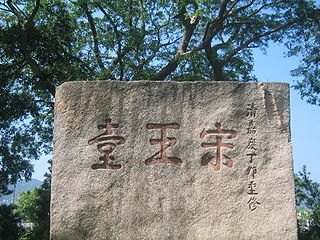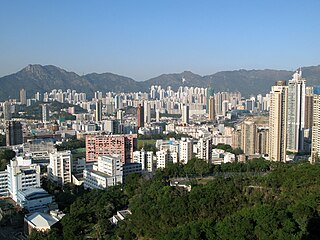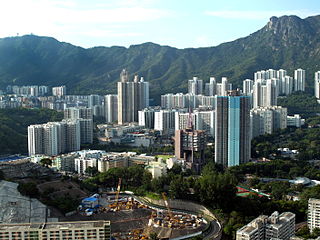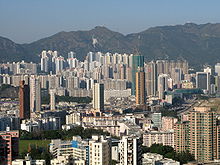
Sai Kung District is one of the 18 districts of Hong Kong. The district comprises the southern half of the Sai Kung Peninsula, the Clear Water Bay Peninsula in the New Territories and a strip of land to the east of Kowloon. Areas in the district include Sai Kung Town, Hong Kong UNESCO Global Geopark, Tseung Kwan O and over 70 islands of different sizes. The administrative centre had been located in Sai Kung Town until the Sai Kung District Office was relocated to Tseung Kwan O recently. The district's population is concentrated in Tseung Kwan O, as of 2011. In 2011, the district was the third youngest district, with a median age of 39.3. Known as the "back garden of Hong Kong", Sai Kung has been able to retain its natural scenery. Many traditional customs and cultures are still retained in the rural villages.

Sung Wong Toi is an important historic relic in Ma Tau Chung, Kowloon, Hong Kong. While its remaining portion is now located in the Sung Wong Toi Garden (宋皇臺花園) at the junction of Ma Tau Chung Road and Sung Wong Toi Road, it was originally a 45-metre-tall boulder standing on the top of Sacred Hill (聖山) in Ma Tau Chung above Kowloon Bay.

Sheung Wan is a station on the Island line of the Hong Kong MTR network. The station serves the neighbourhood of Sheung Wan and the western part of Central District. The livery colour of this station is khaki.

Sheung Shui is an area in the New Territories, Hong Kong. Sheung Shui Town, a part of this area, is part of the Fanling–Sheung Shui New Town in the North District of Hong Kong. Fanling Town is to its southeast.

Ping Shan Heritage Trail is a heritage trail located in the Ping Shan area of Yuen Long District, in Hong Kong. The trail was inaugurated on 12 December 1993. It passes through the villages of Hang Tau Tsuen, Hang Mei Tsuen and Sheung Cheung Wai and it includes several declared monuments and graded buildings.

Sha Tin, also spelt Shatin, is a neighbourhood along Shing Mun River in the eastern New Territories, Hong Kong. Administratively, it is part of the Sha Tin District. Sha Tin is one of the neighbourhoods of the Sha Tin New Town project.

Kowloon City District is one of the 18 districts of Hong Kong. It is located in the city of Kowloon and cut through by Boundary Street. It had a population of 381,352 in 2001, and increased to 418,732 in 2016. The district has the third most educated residents while its residents enjoy the highest income in Kowloon. It borders all the other districts in Kowloon, with Kwun Tong district to the east, Wong Tai Sin district to its northeast, Sham Shui Po district to its northwest, and Yau Tsim Mong district to its southwest.

Ma Tau Chung is an area in Kowloon, Hong Kong, west of Ma Tau Kok and east of Ma Tau Wai. It was named after a creek which originated in Quarry Hill emptying into Kowloon Bay. The village of Ma Tau Chung stood on its banks near the river mouth near the Sacred Hill.
China Aerospace International Holdings Limited is a Hong Kong incorporated holding company. The company itself is a subsidiary of China Aerospace Science and Technology Corporation and a listed company on the Stock Exchange of Hong Kong. It is a red chip company, but not part of the "red chip index" of the stock exchange.
Orient Overseas (International) Limited (OOIL) is a Hong Kong, China based investment holding company involved in international transportation and logistics, and property investment and property development. It is the parent company of Orient Overseas Container Line (OOCL), one of the world's largest container shipping companies.

Lok Fu is a place in Wong Tai Sin District, Kowloon, Hong Kong. It is located to the east of Kowloon Tsai, the west of Wong Tai Sin and the north of Kowloon City. It geographically includes nearby Wang Tau Hom.

The following is an overview of public housing estates in Quarry Hill and No. 12 Hill, Kowloon, Hong Kong, including Home Ownership Scheme (HOS), Private Sector Participation Scheme (PSPS), Sandwich Class Housing Scheme (SCHS), Flat-for-Sale Scheme (FFSS), and Tenants Purchase Scheme (TPS) estates.

Alison Mary Spencer Bell Fok, JP was a Scottish-born Hong Kong doctor and politician. She was the first woman to be elected to the Urban Council of Hong Kong.

The pro-Republic of China camp, or the pro-Kuomintang camp (親國民黨派), is a political alignment in Hong Kong. It generally pledges allegiance to the Republic of China (ROC) in Taiwan and the Kuomintang.
Joseph Hsu King-shing also transliterated as Hsu King-Seng was a Chinese professional football player and manager. Born in Shanghai, Hsu moved to Hong Kong to continue his professional career and never returned to the mainland China to play nor coach. He coached both Hong Kong and Republic of China (Taiwan), as well as managed Singtao for more than a decade.

Edward Hewitt Nichols CBE JP, was a British colonial agriculture and aquaculture official. Having served in Sierra Leone, he then worked in Hong Kong, where, from December 1965 to January 1980, he was the director of the territory's Agriculture and Fisheries Department. From October 1976 to January 1980, he was a member of the Legislative Council of Hong Kong. He was a major proponent of country parks in Hong Kong. He was also a regulator, and promoter, of cooperatives and credit unions.
















